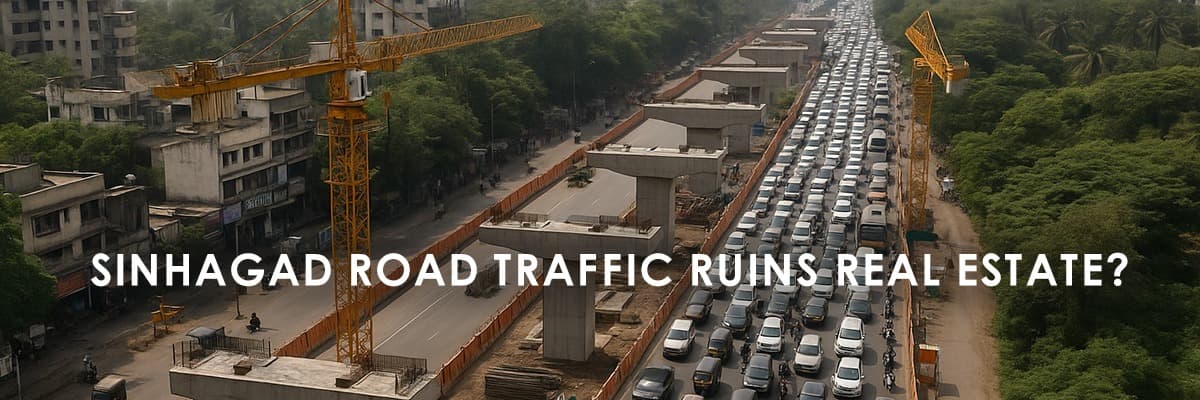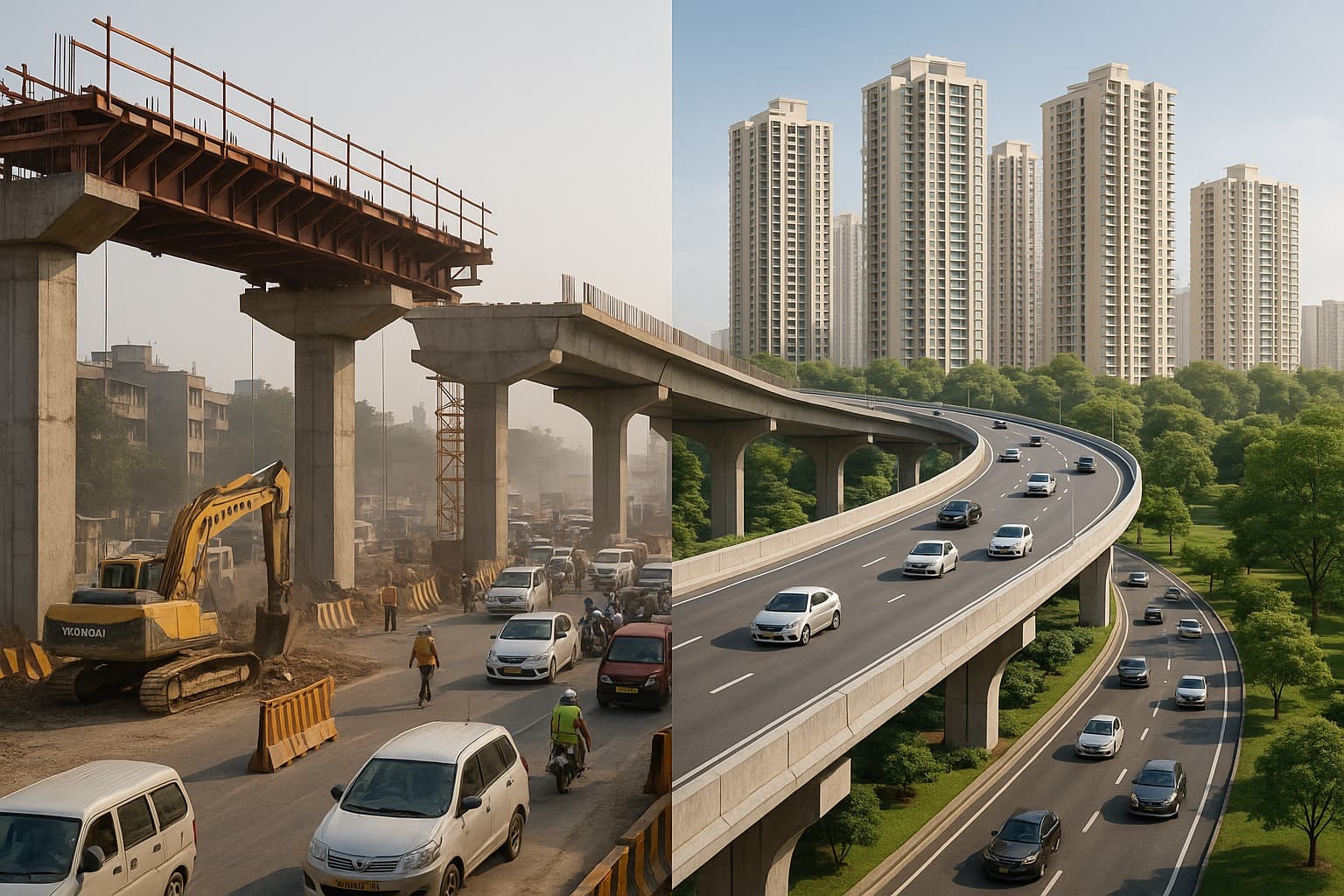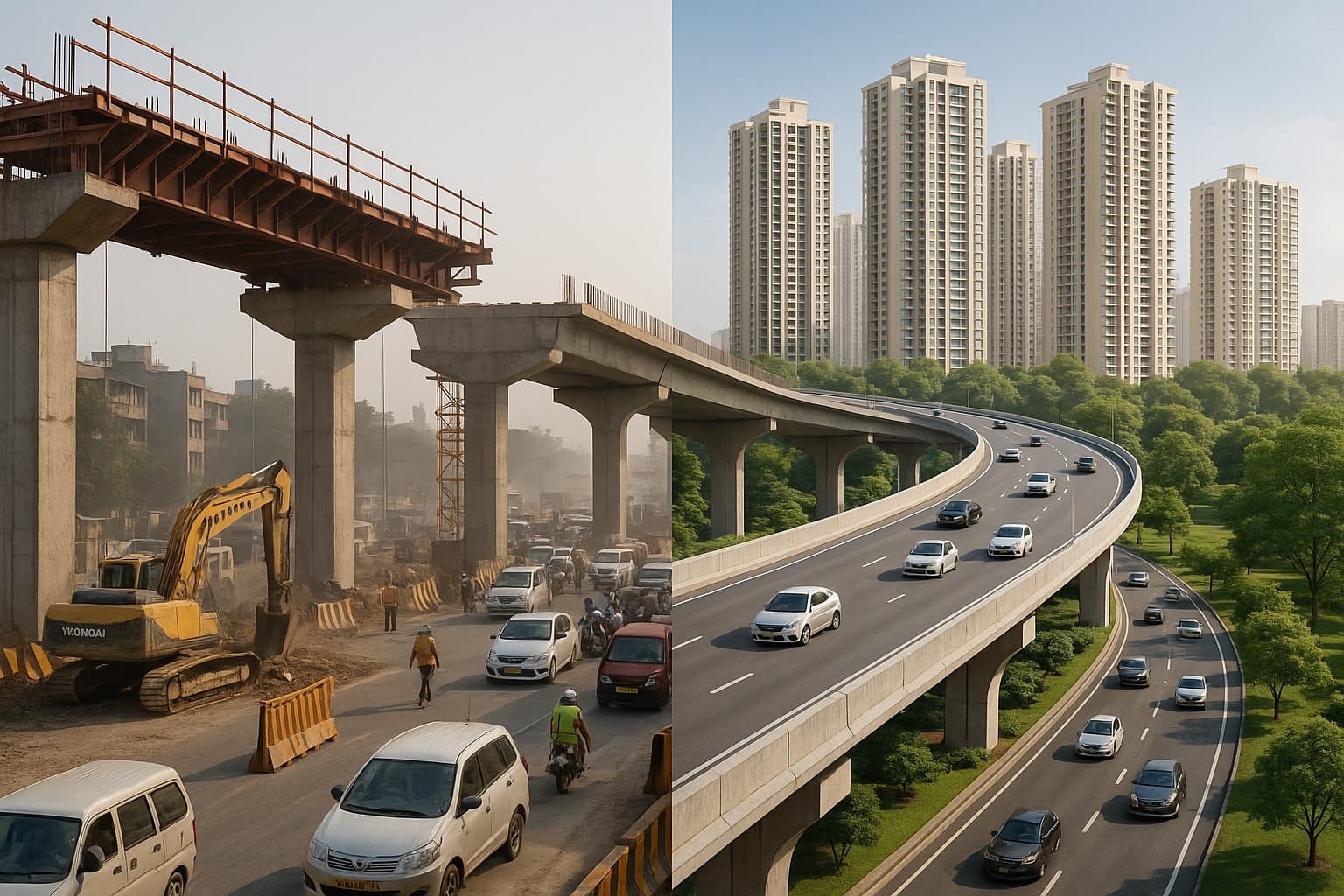Sinhagad Road Flyover Delay 2025: Pune’s Traffic Headache & Real Estate Impact
Summary
The delayed Sinhagad Road Flyover in Pune is causing traffic chaos and impacting real estate. Residents face increased commute times and stress, but the project promises long-term benefits like improved connectivity and property values upon completion in areas like Dhankawadi.

For Pune residents, the daily grind of traffic is no secret. But for those commuting along Sinhagad Road, life has become particularly challenging in 2025. The long-awaited Sinhagad Road Flyover, envisioned as a solution to the city’s growing traffic woes, has been delayed yet again. What was meant to be a smooth, stress-free commute has turned into a test of patience for office-goers, students, and local businesses alike.
The delay of this crucial flyover is more than just an inconvenience; it touches the very rhythm of daily life. It impacts work schedules, school routines, fuel budgets, and even mental health. For residents living in neighborhoods like Dhankawadi, Katraj, and Wanowrie, it’s not just a matter of lost time—it’s lost peace of mind.
Why the Sinhagad Road Flyover Is Critical
Sinhagad Road is more than just a street. It is one of Pune’s most vital arteries, connecting residential zones to commercial hubs, IT parks, and educational institutions. The flyover was planned to decongest this busy stretch, provide faster connectivity, and reduce the relentless honking and chaos that Pune commuters endure daily.
The flyover is also designed to link key traffic points, easing the strain on smaller feeder roads and reducing travel time across the corridor. Its completion would not only benefit residents but also businesses that rely on the free flow of goods and people.
Reasons Behind the Delay
Unfortunately, like many large-scale infrastructure projects, the Sinhagad Road Flyover has faced numerous hurdles:
Land Acquisition Challenges: Acquiring property along a busy corridor with established neighborhoods is never easy, and negotiations have slowed progress.
Technical and Construction Hurdles: Unpredictable soil conditions, structural complications, and monsoon rains have interfered with construction schedules.
Administrative Bottlenecks: Approvals, permits, and inter-agency coordination have added months to the project timeline.
Budget Adjustments: Delays in fund allocation and re-assessment of project costs have caused intermittent halts.
While these challenges are understandable, the human cost is high, with daily commuters bearing the brunt of every delay.
How Pune Commuters Are Affected
The impact of this delay is deeply personal for Pune residents. Every day, thousands of vehicles crowd Sinhagad Road, creating bottlenecks, long queues, and stress.
Morning Rush: From students catching early classes to office employees heading to IT hubs, the road becomes a maze of cars, buses, and two-wheelers.
Evening Rush: Returning commuters face extended hours on the road, often stuck behind traffic that barely moves.
Emergency Services: Ambulances and fire trucks struggle to navigate, sometimes putting lives at risk due to congestion.
The delay isn’t just a traffic problem—it’s a quality-of-life issue. Hours wasted in traffic mean less family time, more stress, and increased fuel expenses.
Real Estate Implications
Infrastructure projects like the Sinhagad Road Flyover play a key role in shaping real estate trends, and the delay has had mixed consequences.
Short-Term Impact
Stalled Property Appreciation: Potential homebuyers and investors often wait for infrastructure improvements before committing.
Business Losses: Shops, cafes, and service providers along the road have experienced fewer customers due to congestion.
Increased Logistics Costs: Delivery vehicles and transport businesses face delays, which impacts profitability.

Long-Term Potential
Once completed, the flyover is expected to transform property values along the corridor:
Residential Boost: Areas like Dhankawadi, Katraj, and Wanowrie will become more attractive due to shorter commute times.
Commercial Growth: Shops, co-working spaces, and offices could see increased demand.
Investment Opportunities: Real estate investors are likely to benefit from property appreciation post-completion.
What Residents Are Feeling
The emotional toll of daily traffic delays is real. Commuters have shared stories of:
Exhausting daily routines: Leaving home early to beat traffic, only to remain stuck for long stretches.
Mental fatigue: The constant stress of unpredictably long commutes can affect overall well-being.
Safety concerns: Narrow lanes, impatient drivers, and frequent bottlenecks increase accident risks.
Despite frustration, residents remain hopeful that once completed, the flyover will bring relief, restore normalcy, and significantly improve their daily lives.
Administrative Measures & Updates
Authorities, including the Pune Municipal Corporation (PMC) and Pune Metropolitan Region Development Authority (PMRDA), have taken steps to mitigate the impact of delays:
Traffic Diversions: Alternative routes have been suggested to ease congestion.
Phased Construction: Work is being carried out in stages to minimize disruption.
Regular Public Updates: Officials provide updates on timelines and project milestones to keep residents informed.
These measures aim to balance ongoing work with commuter convenience, although the complete resolution depends on the flyover’s timely completion.
The Bigger Picture: Urban Development & Pune’s Growth
The Sinhagad Road Flyover is not just a local traffic solution—it’s part of Pune’s broader urban development strategy:

Connectivity Improvement: Linking residential areas to IT parks, offices, and commercial zones.
Real Estate Growth: Areas around the flyover will see better property appreciation and higher demand.
Economic Growth: Businesses will benefit from smoother logistics and customer access.
Environmental Benefits: Reduced vehicle idling will lower fuel consumption and emissions.
This project symbolizes how infrastructure upgrades can improve urban living, not just for commuters but for the city’s economy and environment.
Looking Ahead: The Road to Completion
While the flyover’s exact completion date remains uncertain, authorities have indicated progressive completion in phases post-monsoon 2025. Once finished, residents and businesses can expect:
Shorter commutes: Faster travel across Sinhagad Road during peak hours.
Safer driving conditions: Improved lanes, signage, and road quality.
Real estate growth: Enhanced property values and increased investor interest in surrounding areas.
The completion will transform Sinhagad Road from a daily source of stress to a thriving, well-connected corridor.
Conclusion: More Than Just a Flyover
The Sinhagad Road Flyover delay 2025 is more than just a construction setback. It highlights the intersection of urban planning, daily life, and economic growth. While commuters endure frustration and local businesses face temporary setbacks, the long-term promise of improved connectivity, reduced traffic stress, and increased real estate value makes this wait worthwhile.
Infrastructure projects like this flyover remind us that a city’s growth is a shared journey—every delay is felt personally, but every completion brings relief, opportunities, and renewed hope. For Pune, the completion of Sinhagad Road Flyover will not just ease traffic—it will connect communities, boost investments, and shape the city’s future.
Summary (100 Words)
The Sinhagad Road Flyover delay 2025 has created significant traffic challenges and impacted Pune’s real estate landscape. Daily commuters face congestion, longer travel times, and stress, while businesses experience reduced footfall and logistics delays. Administrative, technical, and funding hurdles have prolonged the project. Despite frustrations, the flyover promises substantial long-term benefits: faster commutes, safer roads, and increased property values in Dhankawadi, Katraj, and Wanowrie. Once completed, it is expected to enhance connectivity, support economic growth, and improve quality of life for residents. The project highlights the importance of infrastructure in shaping Pune’s urban development and future investment potential.
